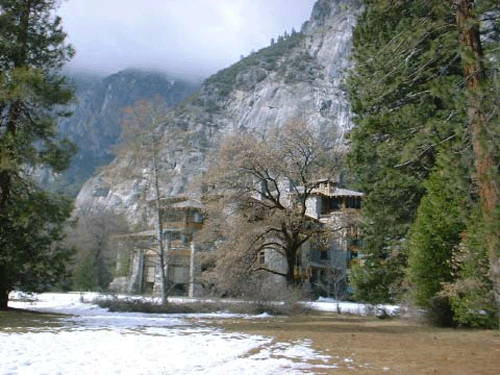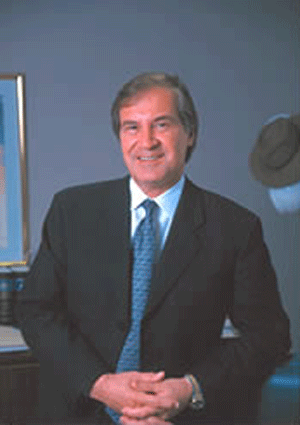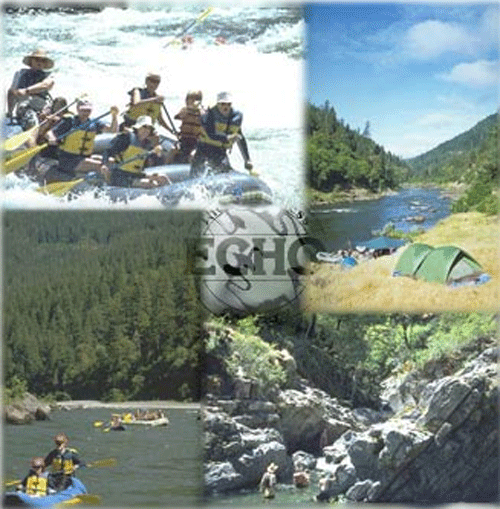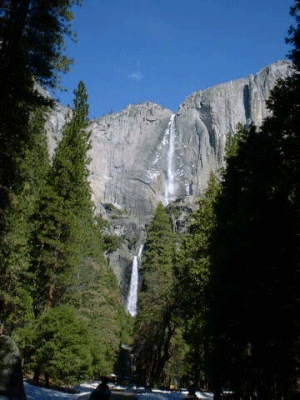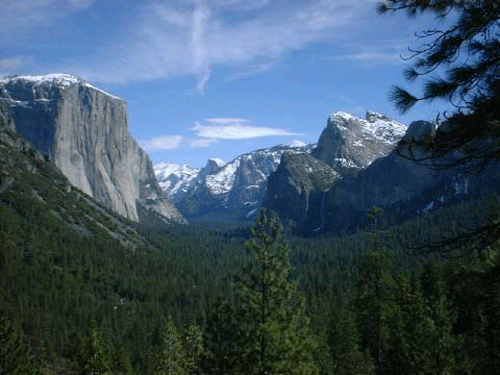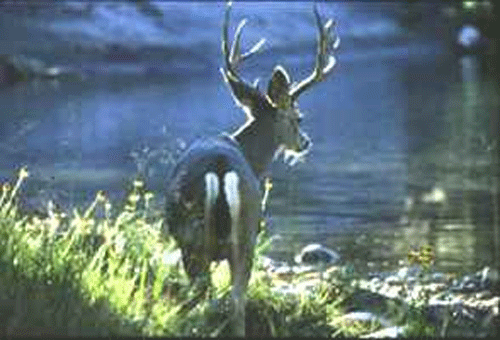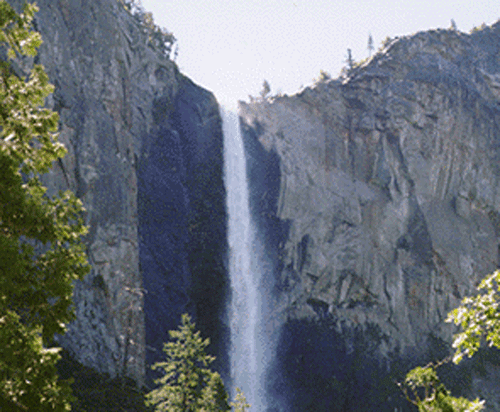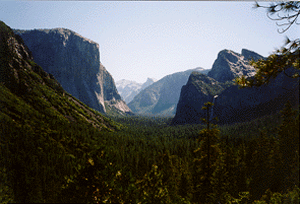Yosemite Firefall by firefall.info
January 25, 1998
NOTICE: THIS WORK MAY BE PROTECTED BY COPYRIGHTYOU ARE REQUIRED TO READ
THE COPYRIGHT NOTICE AT THIS LINK BEFORE YOU READ THE FOLLOWING WORK, THAT IS AVAILABLE SOLELY FOR PRIVATE STUDY, SCHOLARSHIP OR RESEARCH PURSUANT TO 17 U.S.C. SECTION 107 AND 108. IN THE EVENT THAT THE LIBRARY DETERMINES THAT UNLAWFUL COPYING OF THIS WORK HAS OCCURRED, THE LIBRARY HAS THE RIGHT TO BLOCK THE I.P. ADDRESS AT WHICH THE UNLAWFUL COPYING APPEARED TO HAVE OCCURRED. THANK YOU FOR RESPECTING THE RIGHTS OF COPYRIGHT OWNERS.
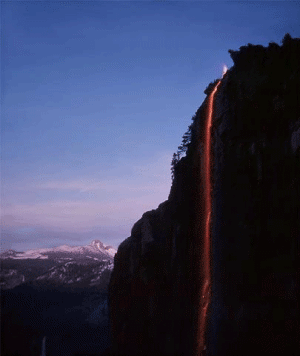 Yosemite Firefall, Mt. Clark (background), and Nevada Fall (lower left corner).
Yosemite Firefall, Mt. Clark (background), and Nevada Fall (lower left corner).
Photographed by Richard Marklin on May 18, 1963.History and A MemoryAt 9:00 each evening in Camp Curry, the crowd which had gathered for the nightly campfire program, would fall silent. A man would call out to the top of Glacier Point "Let the Fire Fall!", and a faint reply could be heard from the top of the mountain. Then a great bonfire of red fir bark would be pushed evenly over the edge of the cliff, appearing to the onlookers below as a glowing waterfall of sparks and fire.
The spectacle was the Yosemite Firefall, a nightly tradition in Yosemite National Park for some 88 years. I witnessed the Firefall myself as a child and still remember it with uncanny vividness.
At about the time of the 30th anniversary of the very last Yosemite Firefall, I felt compelled to compile this history and recollection as a tribute to the lasting impression the Firefall has had on me, and on countless others who have visited Yosemite during its first century as a National Park.
My intention was to present more than just a formal history, but to also provide a mechanism through which others could contribute to the site by recounting their own memories of the Firefall.
These contributions have been compiled in the last chapter of the history. In addition, there is even a contribution embellishing this opening page -- the photo at the top of this page.
I'd like to thank all those who have contributed to this site so far, and welcome any new readers to do the same.
The Mountain HouseThe early history of the Firefall dates back to the late nineteenth century, and has been credited to an Irishman by the name of James McCauley. Some of his story is well-documented, but details surrounding his contribution to the Firefall are not as easy to pin down.
Here is what we know. In 1871 James McCauley obtained permission from the Yosemite Board of Commissioners to build and operate a toll trail to Glacier Point. The trail was to start at the base of Sentinel Rock, then climb over 3,000 feet to its destination at Glacier Point. For the task, he hired Yosemite road-builder John Conway and a team of 9 men, completing the trail over the course of two summers. The project cost McCauley $4,200, which he earned back in tolls over the first two years after opening the trail.
With convenient access to Glacier Point now a reality, innkeeper Charles Peregoy built a small hotel at the overlook, completing its construction in 1873. Hikers ascending McCauley's Four Mile Trail to reach Glacier Point could now elect to rest for the night at The Mountain House, with its stunning views of Half Dome and the rest of Yosemite Valley.
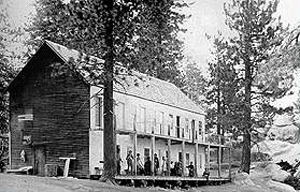
McCauley leased The Mountain House in 1877, but didn't end up operating it himself until the year after his marriage to Barbara Wenger in 1879. The McCauley family ran The Mountain House from 1880 through the summer of 1897. Barbara prepared all the meals and did the housekeeping, and James waited table, tended bar, and entertained the guests.
Now, one account recalls that in 1872, McCauley built a fire near the edge of Glacier Point to entertain his hotel guests. A variation on the account suggests that the fire was built to cook that night's dinner. Then McCauley became upset that not enough people showed up, and out of anger and frustration, ended up pushing the fire over the cliff. Those who witnessed the spectacle on the valley floor were delighted and amazed, and James McCauley had a hit on his hands.
As colorful as this account may be, it is probably somewhat of a distortion of the truth. If the fire was built to entertain guests, it would have had to occur in 1880, or at the very earliest 1873, when The Mountain House was completed. However, there are indications that McCauley did not actually find innkeepers to run the hotel until 1877, when he leased the operation to Thomas and Elizabeth Glynn. And that would place the event much later in the 1870's.
Significantly, we do have an account by one of McCauley's twin sons, Fred McCauley, placing the first Firefall in 1872, and he didn't offer any explanation for why the fire was built or who was there to witness it, stating simply: "Father started the Firefall in 1872 when he pushed his campfire over the Glacier Point cliff."
Fred McCauley went on to detail how he and his twin brother John were employed to prepare the Firefalls for guests in the valley:
"When my brother and I were eight years old, father bought each of us a jackass. We attended school by riding our mules down the Four Mile Trail to the Valley. It took ninety minutes. If a tourist wanted a Firefall, we collected $1.50, the standard fee, before we rode back up the trail to Glacier Point. We had a pack animal that we used to carry provisions for the hotel on our return trip. On the Fourth of July, a collection often amounted to ten or twenty dollars. Then my brother and I were packing wood out to the point on our jackasses for at least two days."
When visitors requested a Firefall they would meet the boys when they left school at 3:30, which was actually a half hour early. The teacher allowed their early departure so they could reach home before nightfall. For their fee, the boys would haul the wood to the top and prepare the fire; and they were eager to do so, since they not only got out of school early, but also got to keep all the money. When the family left the hotel in 1897, the boys had saved some $200 apiece from their Firefall assignment.
The StentorDavid and Jennie Curry moved to Yosemite Valley in 1899 and established a family campground at the base of Glacier Point, called Camp Curry. The camp opened for business on June 1, 1899 and provided accommodations in as many as seven canvas tents, beneath the towering cliff, at a nightly rate of $2. Many, including Yosemite pioneer Galen Clark, predicted that the enterprise wouldn't succeed, since the site was so cold and isolated. Most visitors still preferred the more comfortable accommodations that could be had at the Sentinel Hotel for $4 a night. That summer 4,500 people visited Yosemite Valley and only 290 of them stayed at Camp Curry.
But David Curry had a few ideas to make his camp more attractive to visitors, and one of them was the reintroduction of the Firefall. The attraction was seen only rarely after McCauley's departure from Glacier Point, but Curry intended to make it a nightly tradition. He saw a clear commercial potential in the Firefall, reasoning that crowds would gather each night for the event, and end up patronizing his dining and camping concessions. And it certainly worked! One of the great advantages of staying at Camp Curry, was the very fact that it was isolated in its corner of the valley. Many campers preferred the seclusion of the camp, but most importantly, from the camp one had a perfect view of the Firefall each night.
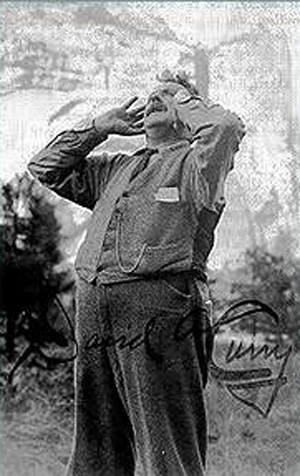
David Curry was well known for his booming voice. He would greet visitors to his camp with a resounding "WELCOME!" which could be heard from a great distance, and would similarly see his guests off by yelling "FAREWELL!" as their wagons pulled away from the main gate. Curry's nickname was "The Stentor", a reference to his loud voice, as illustrated by this little bit he would recite each night at the campfire program as an introduction to the Firefall:
"The original Stentor was a captain in the Greek army in the days of Homer and the Iliad. It was said of him that he could command 10,000 troops by the use of a megaphone. But the modern Stentor lives at Camp Curry in Yosemite Valley, and his voice is heard at Glacier Point, eleven miles distant by the long trail."
He would then throw his head back, cup his mouth with his hands, and shout to the fire tender on Glacier Point, "Is the fire ready?" The faint answer could then be heard, "The fire is ready!" followed by Curry's roaring command "Let 'er go Gallagher!" And the glowing embers would begin their plunge off the edge of the cliff to their resting place on a ledge 1,700 feet below. Presumably Gallagher was the regular fire tender at that time. The call was changed to "Let the Fire Fall!" in later years.
The Firefall was cancelled for a 4 year period between 1913 and 1916 due to a disagreement between David Curry and the Assistant Secretary of the Interior at the time, Adolph C. Miller. Curry had been attempting to convince the Department to sign off on his plans for expanding Camp Curry. But his plans ran counter to the Department of Interior's wishes to halt further expansion in the valley, and to take a more active role in supervising the National Parks. It was not uncommon for Curry to openly complain about the Department and Secretary of the Interior during his nightly campfire programs, and this got back to Miller. The Secretary reportedly took away the Firefall as a way of retaliating against Curry for his belligerence, saying:
"We are not going to do anything for you. I'm not going to give you anything you ask for. Furthermore, I'm going to take something away from you... I'm going to take the Firefall away. There will be no Firefall."
The Firefall was reinstituted in the summer of 1917, however David Curry never got a chance to see the spectacle again, as he died of blood poisoning in April of that year.
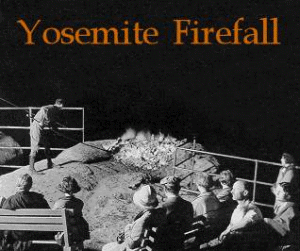 The Curry Legacy
The Curry LegacyCurry's wife Jennie and son Foster Curry (young Foster pictured here at age 11) took over the operations of Camp Curry after David Curry's death. The highlight of that summer was the reintroduction of the Firefall, described by employee John Fahey:
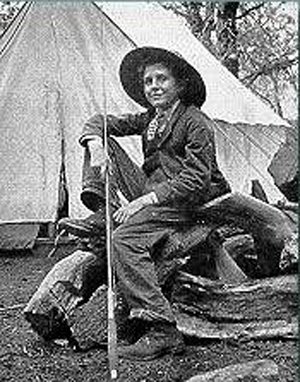
"My greatest thrill was being given the assignment of throwing the first Firefall from Glacier Point. Another fellow and I climbed the Ledge Trail to gather pine cones, start the fire and, at 8:30 pm, when the lights were out in the camp below, we heard the Stentorian voice of Foster Curry shouting, LET 'ER GO GALLEGHER."
During World War I, one of the fire builders, Herbert Wilson, was urged by Foster Curry to put some zip into the Firefall. He made bigger fires, which created longer falls, and even established a record in climbing up the trail from camp to point in 54 minutes. Wilson worked the Firefall detail for 15 years.
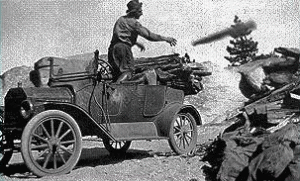
Another regular fire builder during the 1920's was Alex Beck who would use an open-roofed touring car to haul the red-fir bark for the fire down to the cliff's edge. He would light the fire an hour or so before 9:00 pm then push it off slowly with a long-handled rake. On one Fourth of July he pushed off three Firefalls simultaneously: a big one he dedicated to his wife, and two smaller, flanking ones for his two daughters. During this period, to insure proper timing, a light, that shone from the top of a tall pine tree in Camp Curry, was switched on just before the first call to alert the team on the cliff.
A large warning sign was erected at this time in an attempt to keep people from climbing out onto the precarious Overhanging Rock, and from standing too close to the edge of the cliffs at Glacier Point. The sign was rather blunt and read:
It is 3,000 feet to the Bottom
And no undertaker to meet you
TAKE NO CHANCES
There is a difference
Between bravery and just plain
ORDINARY FOOLISHNESS
When pipe railings were finally installed on the cliff's edge, the sign disappeared. Alex Beck chopped it up, mixed the wood in with the normal red-fir bark, and let it go over the edge with the next Firefall.
When Foster Curry took ill with leukemia, he told his wife and mother that he wanted his ashes pushed over the cliff with a Firefall. But his mother refused, saying: "If that were done, I could never bear to look at a Firefall again!" He died in 1932, and a few months later, a small plane flew over Yosemite and scattered his ashes over the valley.
The War YearsAt the onset of World War II, the Firefall was again cancelled, and was not reinstituted until after the war's end. During the war,Yosemite Valley was used by the military. Camp 11, now known as Upper Pines Campground became a small army camp. And the Ahwahnee Hotel served as a navy convalescent hospital.
Even though the Firefall was in limbo, in 1943 the resident army commander asked the new park superintendent Frank Kittredge to make an exception and prepare a Firefall for the troops. Stewart Cramer, a young resident in the valley at the time, described the event:
"The request was given to the Curry Company and passed along to my father. I was twelve at the time. Together, we climbed the Four Mile Trail, still covered with snow at the top, and let ourselves into the boarded-up Mountain House, where we spent the night. The next day we built the fire, and after dark showed the army and everyone else a near record-sized firefall."
Recent MemoriesNic Fiore, Glacier Point Hotel innkeeper and fire builder from 1954 and beyond, remembers that his normal routine was to start gathering bark for the fire between 4:30 - 5:00 am, so it could be done before tourists arrived to enjoy the view of the valley from Glacier Point.
He would build the fire with 10 wheel barrels full of red-fir bark. Even that early in the morning, invariably someone would want to take a picture with him holding up one of the pieces of bark, and he would never disappoint them. The fire would be started at 7:00 in the evening so that it could burn down to glowing embers by 9:00.
Down at Camp Curry, the crowds would start to gather at 6:00 in the evening to get a seat at the outdoor stage, and would wait two hours for the show, which ran from 8:00 to 9:00, ending with the Firefall as its finale. The fire builder on Glacier Point and another individual near the Camp Curry stage would signal to each other by flashlight. When contact was made, the calls would begin.
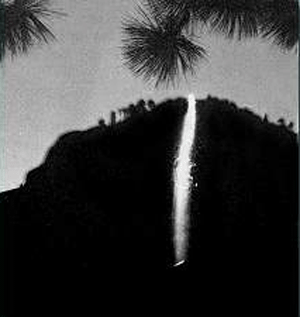
The fire caller at Camp Curry would yell in a loud voice: "Hello Glacier!" In the dead silence, the crowd could hear the faint response from the cliff: "Hello Camp Curry!" The fire caller would then yell: "Let the Fire Fall!" And the crowd could hear the final response: "The Fire is Falling!" At that point the fire would be gradually and consistently pushed over the edge. Great care was taken to ensure that the embers were pushed evenly off the edge, to simulate a steady flow and produce the illusion of a waterfall of fire.
While the fire was falling, a performer on the Camp Curry stage would sing The Indian Love Call, accompanied by piano or violin. When the song and the Firefall was over, the crowd would remain silent. Bill Lane, fire caller from the 1930's up through 1942, described the mood afterwards:
"Then there would usually be a pause, and I have seen many people cry at the end of the program. And it would be what would seem like minutes, although it was probably 30 seconds or so, then there would be the sound of a few people bold enough to clap, to break what was really almost a spiritual experience. And then pretty soon the crescendo of the clapping, and you could hear the clapping from the meadows, and then from all over the valley."
In 1954, the year I was born, Yosemite National Park visitors exceeded 1 million for the first time. The Firefall was a well-established tradition by the time my family began to visit the park, and was viewed by more and more spectators each year.
As a child, I remember the excitement of the Firefall. The crowds would begin to gather for the nightly campfire at Camp Curry early in the evening, and as the time for the Firefall approached, the anticipation was almost unbearable. What impressed me the most was when the fire caller asked the crowd for silence, and the exchange of calls began. I was astounded by the fact that the human voice could carry so far to the top of that cliff, over 3,000 feet into the night sky. It was almost unbelievable!
And then it fell, looking nothing like the time-exposure photography that would appear on postcards, depicting that solid line of orange extending down the cliff. Instead, it would be little sparks -- thousands and thousands of individually discernible sparks -- floating down the cliff in complete silence.
It took me some time to write those last paragraphs, because each time I made a revision and read it back I would get very emotional. When I first started researching this project, I experienced similar moments, fighting back tears (or not) while fleshing out the story of this tradition. At first I felt a bit silly getting so worked up about it, until I viewed a documentary about the Firefall, and saw Bill Lane (quoted above) moved to tears by the time he ended his account. The interviewer's voice was breaking as well! What is it about these memories that make their retelling so poignant and moving?
My best guess is that the Firefall was not just a spectacle, not just entertainment. Instead, it approached the sublime in the way that it touched those who witnessed it. Thousands of onlookers felt something in common for that short period of time. It was something parents shared with their wide-eyed children, and something that those children would never forget. It illustrated how grand Yosemite really was; how unspeakably tall were its cliffs; how quiet its forest; and how much we treasured the company of our family and our friends.
The End of a TraditionIn 1968 the Park Service Director decided that the Firefall tradition should come to an end. He reasoned that since it was just a man-made attraction, and one which caused a great deal of congestion in the park, as well as damage to the meadows from the trampling of onlookers, that it wasn't worth continuing. He went as far as to point out that it caused the unnatural and unnecessary removal of red-fir bark from the park grounds. Henry Berrey, who was in charge of public relations for the park at the time, described the last Firefall in this press release:
The Firefall, a fancy of James McCauley's that caught on, and was popular for almost a hundred years, died Thursday, January 25, 1968 in a blazing farewell.
It was a dandy Firefall, fat and long and it ended with an exceptionally brilliant spurt, the embers lighting the cliff as they floated slowly downward...
There weren't many people around to watch. Maybe fifty. Hardly any congestion at all.
In my research of the Firefall, I was struck by how differently writers view the event. The accounts vary from the sentimental to the cynical. We're all grown up now, and such things as pushing fire over a cliff are considered foolish and irresponsible. But for those who experienced the Firefall in person on one of those dark summer evenings: I think they will have changed because of it, and will always look back on it with a sense of nostalgia and wonder.
A pale scar remains to this day, where the fire burned away the cliff's lichen. Someday that scar will heal, and after that, all those who remember the Firefall will also pass, and this colorful and oddly magical tradition will remain only in the pages of history.
About the photo:The Firefall picture above was graciously contributed by Judy Simpson whose father, Richard Marklin, took the photo in the spring of 1963.
On careful observation, you might question why the sky was light in the photo. The Firefall, as you'll learn in the history, was always presented in the evening after nightfall! Marklin explains how the image was captured:
The picture was taken with a Stereo Realist camera using 35mm Kodachrome with a film speed of 25. The picture was a double exposure. The background mountains were taken one or one and a half stops underexposed at about 6:00 PM. The camera was left in position on a tripod until 9:00 PM when the Firefall was started.
The camera lens was left open for the entire time that there was visible fire coming down the face of Glacier Point. It would be difficult to describe the exact location from which the picture was taken because it was a lateral off of the original shortcut trail from Camp Curry up to Glacier Point. This shortcut trail is now intentionally obscured by the park rangers because of at least two deaths caused by reckless hikers running down the trail and getting themselves killed by going over a cliff.
The slides were in very good condition for being 35 years old. However there was some amount of retouching required. I was faced with a decision between attempting to prepare both the left and right sides of the stereo image for presentation, or combining the two images into one. I decided on the latter, and combined the left slide, which included Nevada Fall, with the right slide which included more detail at the top of the cliff.
Consequently, the photo was created with the age-old photographic effect of double exposure, then prepared for publication using the rather newer techniques available in present-day image enhancement software to combine the two images into one. I was very happy with the final product, and am quite proud to open the Yosemite Firefall site with such a unique and fitting photo. Thank you Judy Simpson, and Richard Marklin for your contribution to the Firefall project.
